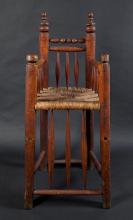When I arrived at AAS in 1996 to immerse myself in research for Nightbirds in the Age of Light, a novel based on the Salem witchcraft trials, I had only recently begun writing it, but my interest in this period and place as the occasion for a novel dated back to my time in Provincetown, Massachusetts, in the late 1970s and early 1980s as a fellow of the Fine Arts Work Center. Although I didn’t know then how I would approach the material, I did know I was envisioning an enormous project, and it was many years of reading later before I had a sense of which characters would be central in the novel and the narrative arc that would shape it. This was the stage I had reached, along with drafting a few early chapters, when I arrived at AAS.
Many original and secondary sources were available in print by then, and at AAS I was able to expand my reading of contemporary scholarship to identify newer studies relevant to my characters and their world. But more significant than these were the older, original 17th century volumes there. Just as walking in Danvers in the locations where the crisis started had contributed to my bodily understanding and sense of scale, so did holding in my hands various volumes from the Cotton Mather Library offer substance to the imagination and contribute to the significance books would play in my fictional version of the historical events.
Studying The Protestant Tutor for Children concretely fed an awareness of how the afflicted and accusing children were educated. An early edition of Richard Ligon’s A True and Exact History of the Island of Barbados (in 1996 not yet available in a contemporary reprint) provided material important to my version of Tituba’s life. I was able to browse an early dictionary of French and Abenaki, genealogical and legal records relevant to Mercy Lewis, an early medical text in use and circulation in Massachusetts at the time, the Esther Forbes papers, Michael Dalton's The Countrey Justice and so on; and the Cotton Mather high chair added a palpable poignancy to Mather’s grief at the death of a child (the Mather of 1692 a young man still in formation and a young father). One of the most vivid Worcester memories that entered the novel is not of the collection at all, but of the view from my window on a snowy moonlit night.
I completed the first draft in 2014, after a long interruption for a decade and more of Zen training. Every year since then I’ve returned to Nightbirds for revision, and although “Invocation,” the prologue of the novel, appeared in New England Review in 2018, the novel as a whole (at 190,000+ words) remains unpublished.
